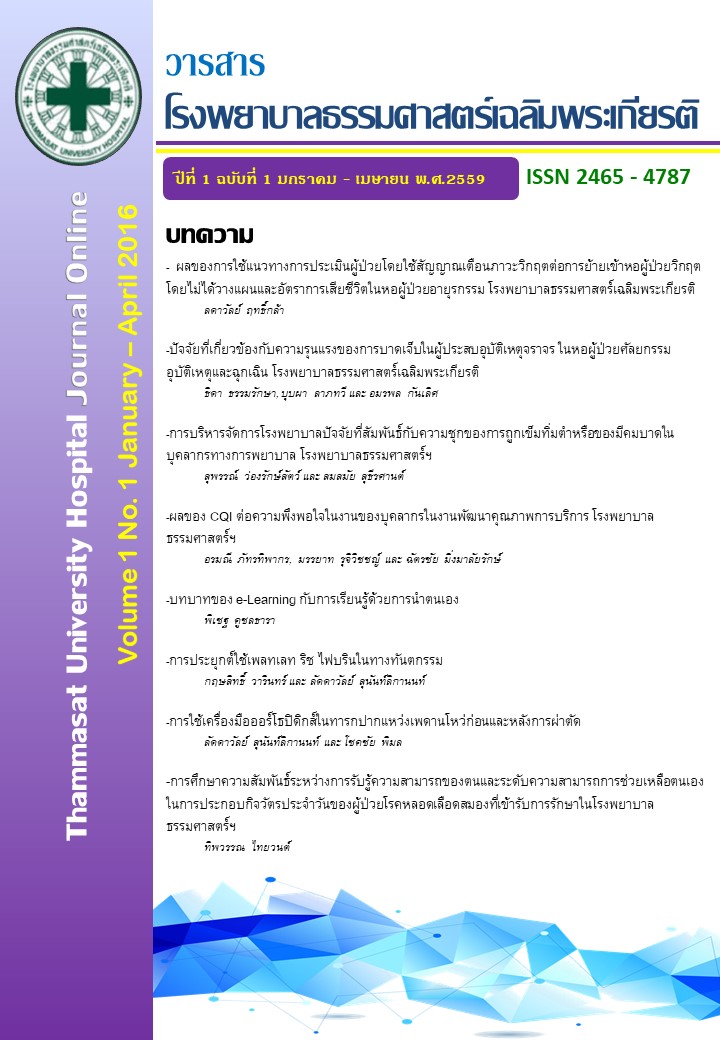The Relation between Self-Efficacy and Activities of Daily Living Performance of Stroke Clients admitted in Thammasat University Hospital
Keywords:
Self-efficacy, Activities of Daily Living, StrokeAbstract
Objective: This Descriptive Research aimed to study the interrelationship between the self-efficacy of people’s ability to do activities and their Activities of Daily Living (ADL) performance. The participants were clients with stroke who were admitted for treatment in post-acute and rehabilitation phases at Thammasat University Hospital.
Methodology: Sample selection were done using accidental sampling and through volunteers. There were 30 participants with the mean age of 55 years old. The Stroke Self-efficacy Questionnaire was used to assess participants’ self-efficacy of their abilities to do activities and the Barthel Index Scoring Form was used to assess the capacity of participants to perform ADL. Statistical analysis used was the mean, standard deviation and Spearman Rank Correlation Coefficient (r) between the participants’ perceived self-efficacy and their ADL performance.
Results: This research found that one’s perceived self-efficacy has a mean score of 94 out of 130, while mean ADL performance score was 78 referring to moderate performance. The self-efficacy is positively interrelating with ADL performance in people with stroke. The statistical significance is of 0.05
References
กมลทิพย์ หาญผดุงกิจและกิ่งแก้ว ปาจรีย์. (2547). การฟื้นฟูสมรรถภาพผู้ป่วยโรคหลอดเลือดสมอง. กรุงเทพมหานคร: งานตำราวารสารและสิ่งพิมพ์สถานเทคโนโลยีการศึกษาแพทยศาสตร์ คณะแพทยศาสตร์ศิริราชพยาบาล มหาวิทยาลัยมหิดล.
จุฬาภรณ์ โสตะ. (2546). กลยุทธ์การพัฒนาพฤติกรรมสุขภาพ. ขอนแก่น: คณะสาธารณสุขศาสตร์ มหาวิทยาลัยขอนแก่น
เจือจันทร์ วัฒกีเจริญ. (2549). การนำเสนอโปรแกรมการเชื่อในความสามารถแห่งตนในการฟื้นฟูสภาพที่บ้านของผู้ป่วยโรคหลอดเลือดสมอง (A propose self-efficacy program in home-base rehabilitation for post stroke patient). จุฬาลงกรณ์มหาวิทยาลัย, กรุงเทพมหานคร.
ทศพล ภูรัดสาย. (2548). ความสัมพันธ์ระหว่างความเชื่อในสมรรถนะแห่งตนกับความสามารถในการทำกิจวัตรประจำวันในผู้ป่วยโรคหลอดเลือดสมอง. มหาวิทยาลัยเชียงใหม่, เชียงใหม่.
นิธิกานต์ อินก้อนวงค์. (2548). ความสัมพันธ์ระหว่าง Cognitive function และความสามารถในการทำกิจวัตรประจำวันในผู้ป่วยโรคหลอดเลือดสมอง. มหาวิทยาลัยเชียงใหม่: ภาควิทยานิพนธ์วิทยาศาสตรบัณฑิต(กิจกรรมบำบัด) คณะเทคนิคการแพทย์.
ประคอง อินทรสมบัติและคณะ. (2550). แนวทางการพยาบาลผู้ป่วยโรคหลอดเลือดสมอง สำหรับ พยาบาลทั่วไป. กรุงเทพฯ: สถาบันประสาทวิทยา; ภาคผนวกที่ 6, หน้า 58-59
ประทีป จินงี่. (2539). ผลการเตือนตนเองต่อการรับรู้ความสามารถของตนเองที่ส่งผลต่อการเพิ่มประสิทธิภาพการทำงานตามที่ได้รับมอบหมายของนักศึกษาระดับประกาศนียบัตรวิชาชีพ. กรุงเทพมหานคร: สถาบันวิจัยพฤติกรรมศาสตร์ มหาวิทยาลัยศรีนครินทร์วิโรฒ ประสานมิตร.
ประทีป จินงี่. (2540). การวิเคราะห์พฤติกรรมและการปรับพฤติกรรม. กรุงเทพมหานคร: สถาบันพฤติกรรมศาสตร์มหาวิทยาลัยศรีนครินทรวิโรฒ. หน้า 110-133
พรทิพย์พา ธิมายอมและคณะ (2555). ผลของการใช้โปรแกรมพัฒนาการรับรู้ความสามารถของตนที่มีต่อพฤติกรรมการดูแลตนเองของผู้ป่วยอัมพาตครึ่งซีก. วารสารพฤติกรรมศาสตร์เพื่อการพัฒนา, ปีที่ 4(ฉบับที่ 1).
พรภัทร ธรรมสโรช (2554). ผลการรักษาผู้ป่วยโรคหลอดเลือด สมองตีบและอุดตันระยะเฉียบพลัน ชาวไทยด้วยยาละลายลิ่มเลือด (Outcomes of Thai patient with acute ischemic stroke after intravenous thrombolysis). 3(20), 247-250.
พศิน วิริยะนานนท์. (2547). การศึกษาความเชื่อในประสิทธิภาพแห่งตนกับการทำกิจวัตรประจำวันในผู้ป่วยบาดเจ็บไขสันหลังในชุมชน. มหาวิทยาลัยเชียงใหม่, เชียงใหม่.
พัชรินทร์ เจริญผล (2555). แนวทางการดูแลผู้ป่วยโรคหลอดเลือดสมองเฉียบพลัน. (ฉบับที่ l. 2, หน้า 2/5). จังหวัดสระบุรี: โรงพยาบาลมวกเหล็ก.
มัยธัช สามเสน. (2551). พบคนไทยป่วยโรคหลอดเลือดสมองเกือบ 5 แสน, หนังสือพิมพ์บ้านเมือง. 3 มิถุนายน 2551
วันวิสาข์ อินทรัตน์. (2546). ความสัมพันธ์ระหว่างความสามารถในการทำกิจวัตรประจำวันกับคุณภาพชีวิตของผู้ป่วยโรคหลอดเลือดสมอง. มหาวิทยาลัยเชียงใหม่: ภาควิทยานิพนธ์วิทยาศาสตรบัณฑิต(กิจกรรมบำบัด) คณะเทคนิคการแพทย์.
วัลลภา โคสิตานนท์. (2542). ผลของการปรึกษาเชิงจิตวิทยาแบบกลุ่มตามแนวพิจารณาเหตุผล อารมณ์และพฤติกรรมต่อการลดความว้าเหว่ในผู้สูงอายุ. กรุงเทพมหานคร: จุฬาลงกรณ์มหาวิทยาลัย.
สมโภชน์ เอี่ยมสุภาษิต. (2536). ทฤษฎีและเทคนิคการปรับพฤติกรรม. จุฬาลงกรณ์มหาวิทยาลัย, กรุงเทพมหานคร.
สันติ จันทวรรณ. (2548). การศึกษาชนิดของ Cognitive deficit ขณะทำกิจวัตรประจำวัน (ADL) ในผู้ป่วยโรคหลอดเลือดสมอง. มหาวิทยาลัยเชียงใหม่: ภาควิทยานิพนธ์วิทยาศาสตรบัณฑิต(กิจกรรมบำบัด) คณะเทคนิคการแพทย์.
สุทธิชัย จิตะพันธ์กุล. (2541). หลักสำคัญของเวชศาสตร์ผู้สูงอายุ. จุฬาลงกรณ์มหาวิทยาลัย, กรุงเทพมหานคร.
Bandura, A. (1982). Social foundation of thoughts and action: A social cognitive theory. NJ: Prentice-Hall: Englewood Cliffs.
Campbell, N. K., & Hackett, G. (1989). The effects of mathematics task performance on math self-efficacy and task interest. Journal of Vocational Behavior, 28, 149-162.
Evans, R. I. (1989). Albert Bandura: The man and his ideas-a dialogue. NY: Praeger.
Gage, M., & Polatajko, H. (1994). Enhancing Occupational Performance Trough and Understanding of Perceived Self-efficacy. American Journal of Occupational Therapy, 48(5), 452-461.
Gibson, Sherri, Dembo, & Myron H. (1984). Teacher efficacy: A construct validation. Journal of Educational Psychology, 76(4), 569-582.
Gordon, J. R. (1999). Organizational behavior : A diagnostic approach. Saddle River: NJ : Prentice Hall International.
Greenberg, L. S. (2002). Emotion-focused therapy. Washington D.C.: American Psychological Association.
Hinkle DE, Wiersma W, & SG., J. (1998). Applied Statistics for the Behavioral Science. Boston: Houghton Mifflin Company.
Kazdin, A. (1974). Reactive self-monitoring: The effect of response desirability, goal setting and feedback. Journal of Consulting and Clinic Psychology.
Khemthong, S.(2009). Forward-Backward translation from Jones F.,Reid F. The stroke self-efficacy questionnaire: measuring individual confidence in function performance after stroke. J Clin Nurs 2008; 17(7b), 244-52.
Khemthong, S., Posawang, P., & Thimayom, P. (2009). Effectiveness of health system program with occupational therapy on quality of life and self-efficacy after stroke. The Journal of Occupational Therapist Association of Thailand, 4(3), 26-34.
Mahoney, F., & Barthel, D. (1965). Functional evaluation: the Barthel Index. Maryland State Medical Journal, 14, 56-61.
Meyer, J. E. (1993). New paradigm research in practice: the trials and tribulations of action research. J Adv Nurs, 18, 1066-1072.
Pedretti, L. W. (1981). Occupational Therapy Practice skills for physical dysfunction. St. Louis: Mosby.
Reed, K., & Sanderson, S. (1980). Concept of Occupational Therapy. Baltimore: Williams & Wiskins
Rinehart, & Winston. (1969). Principles of behavior modification. New York: Holt.
Smith, R. E. (1989). Effects of coping skills training on generalized self-efficacy and locus of control. J Pers Soc Psychol, 56, 228–233.
Trombly, C. A., & Scott, A. D. (1983). Occupational Therapy for phasical dysfunction. Baltimore: Williams & Wilkins.
Wood, R., & Bandura, A. (1989). Impact of conceptions of ability on self-regulatory mechanisms and complex decision making. J Pers Soc Psychol, 56(3), 407-415.
World Health Organization Meeting on Community Control of Stroke and Hypertension. (1973). Control of stroke in the community: methodological considerations and protocol of WHO register, 73.6. Geneva: C



